by Bruce Wells | May 24, 2023 | Petroleum History Almanac
“Gentlemen, it appears to me that there is much ground for encouragement in the belief that your company have in their possession a raw material from which, by simple and not expensive processes, they may manufacture very valuable products.” — Yale Professor Benjamin Silliman Jr. in his 1855 report to the Pennsylvania Rock Oil Company.
Less than 10 months after former railroad conductor Edwin L. Drake completed the first commercial U.S. oil well in August 1859 along Oil Creek in Titusville, Pennsylvania, Thomas A. Gale wrote a detailed study about the new rock oil — petroleum.
The Wonder of the Nineteenth Century: Rock Oil in Pennsylvania and Elsewhere described a radical fuel source for the popular lamp fuel kerosene, which had been made from coal for more than a decade.
“Those who have not seen it burn, may rest assured its light is no moonshine; but something nearer the clear, strong, brilliant light of day,” Gale declared in his 1860 pamphlet, published by Sloan & Griffith and sold for 25 cents.
“In other words, rock oil emits a dainty light; the brightest and yet the cheapest in the world; a light fit for Kings and Royalists, and not unsuitable for Republicans and Democrats,” Gale added.
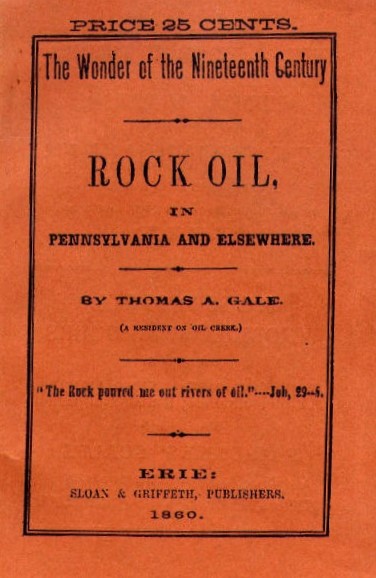
Thomas Gale’s 80-page pamphlet in 1860 marked the beginning of the petroleum age, illuminated with kerosene lamps.
Gale’s descriptions of the value of petroleum helped launch investments in new exploration companies. He noted the commercial qualities of Pennsylvania oil for refining into kerosene (today also used as a rocket fuel).
Rock Oil
Oil patch historians regard Gale’s 80-page pamphlet as the first book about America’s new petroleum industry.
In 1952, the Ethyl Corporation of New York republished Gale’s historic The Wonder of the Nineteenth Century: Rock Oil in Pennsylvania and Elsewhere.
“Not by the widest stretch of the imagination could Thomas Gale have realized, when he put down his pen on June 1, 1860, that he had written a book destined to become one of the rarest of all oil books,” noted the Ethyl historian in 1952 when the company republished Gale’s work. Only three copies were known to exist in 1952.
Ethyl Corporation noted the scarcity of copies of the book had prevented “all but a few historians” from giving the book the attention it deserved. “Gale wrote his book to satisfy a public desire for more information about petroleum. Newspapers had carried belated accounts of Drake’s discovery well, and the mad scramble for oil that followed, but actually the world new little about petroleum.”

The book’s 11 chapters explained practical aspects of the new petroleum industry. Chapters one and two, “What is Rock Oil?” and “Where is the Rock Oil found?” were followed by “Geological structure of the oil region.”
Chapters four though six explained the early technologies (and costs) for pumping the oil, while the next two chapters examine “Uses of Rock Oil.” The final three chapters offered “Sketches of several oil wells,” “History of the Rock Oil enterprise,” and “Present condition and prospects of Rock Oil interests in difference localities.”
Originally published by Sloan & Griffith of Erie, Pennsylvania, the 1860 cover noted the author as “a resident of Oil Creek” and included a biblical quote:
“The Rock poured me out rivers of oil,” from Job, 29:6.
Was Thomas Gayle’s 1860 work the first oil book, as Ethyl Corporation historians believed when they reprinted it in 1952? Natural oil and gas seeps were recorded millennia ago (including the Bible), according to a geologist who has researched the earliest sightings of petroleum.
Writers around the world have noted coal, bitumen, and substances like petroleum — a word derived from the Latin roots of petra, meaning “rock” and oleum meaning “oil.”

Ethyl Corporation was established in 1923 by General Motors and Standard Oil of New Jersey,
Ethyl Corporation had been founded in 1923 by General Motors and Standard Oil of New Jersey in response to consumer demand for an improved automobile gasoline. The new company at first downplayed the danger of its tetraethyllead, a fuel additive that proved vital for aviation (and still is). The leaded fuel was banned for use in car engines in the 1970s.
Petroleum Product
Several years prior to Drake’s historic 1859 oil well, businessman George Bissell had hired a prominent Yale chemist to study the potential of oil and its products to convince potential investors.
“Gentlemen, it appears to me that there is much ground for encouragement in the belief that your company have in their possession a raw material from which, by simple and not expensive processes, they may manufacture very valuable products,” reported Benjamin Silliman Jr. in 1855.
Silliman’s groundbreaking “Report on the Rock Oil, or Petroleum, from Venango Co., Pennsylvania, with Special Reference to its Use for Illumination and Other Purposes,” convinced the petroleum industry’s earliest investors to drill at Titusville. Cable-tool technology developed for brine wells would drill the well.

According to historian Paul H. Giddens in the 1939 classic, The Birth of the Oil Industry, Silliman’s 1855 report, “proved to be a turning-point in the establishment of the petroleum business, for it dispelled many doubts about its value.”
The Pennsylvania Rock Oil Company would evolved into the Seneca Oil Company of New Haven, Connecticut, which became America’s first oil company after Drake completed the first U.S. commercial well drilled seeking oil in 1859.
Learn more in George Bissell’s Oil Seeps.
_______________________
Recommended Reading: The Wonder of the Nineteenth Century: Rock Oil in Pennsylvania and Elsewhere (1952); The Birth of the Oil Industry (1939); Myth, Legend, Reality: Edwin Laurentine Drake and the Early Oil Industry (2009). Your Amazon purchase benefits the American Oil & Gas Historical Society. As an Amazon Associate, AOGHS earns a commission from qualifying purchases.
(2009). Your Amazon purchase benefits the American Oil & Gas Historical Society. As an Amazon Associate, AOGHS earns a commission from qualifying purchases.
_______________________
The American Oil & Gas Historical Society (AOGHS) preserves U.S. petroleum history. Become an AOGHS annual supporting member and help maintain this energy education website and expand historical research. For more information, contact bawells@aoghs.org. Copyright © 2023 Bruce A. Wells. All rights reserved.
Citation Information – Article Title: “First Oil Book of 1860.” Authors: B.A. Wells and K.L. Wells. Website Name: American Oil & Gas Historical Society. URL: https://aoghs.org/oil-almanac/first-oil-book-of-1860. Last Updated: May 24, 2023. Original Published Date: May 31, 2020.
by Bruce Wells | May 16, 2023 | Petroleum History Almanac
Marketing icon “Dino” and Jurassic friends first appeared at 1933 World’s Fair in Chicago.
Harry Ford Sinclair establish his petroleum company in 1916, making it one of the oldest continuous names in the U.S. energy industry. Appearing among other Sinclair Oil Company dinosaurs during the 1933-1934 World’s Fair in Chicago, “Dino” quickly became a marketing icon whose popularity – and educational value – with children remains today.
With $50 million in assets, Harry Ford Sinclair borrowed another $20 million and formed Sinclair Oil & Refining Corporation on May 1, 1916. Sinclair brought together a collection of several depressed oil properties, five small refineries and many untested leases-all acquired at bargain prices.

Today known more correctly as Apatosaurus, in the 1960s a 70-foot “Dino” traveled more 10,000 miles through 25 states – stopping at shopping centers and other venues where children were introduced to the wonders of the Mesozoic era courtesy of Sinclair Oil.
In its first 14 months, Sinclair’s New York-based company produces six million barrels of oil for a net income of almost $9 million. The company’s refining capacity grew from 45,000 barrels of oil a day in 1920 to 100,000 barrels of oil a day in 1926. Refining capacity reached 150,000 barrels of oil per day in 1932.
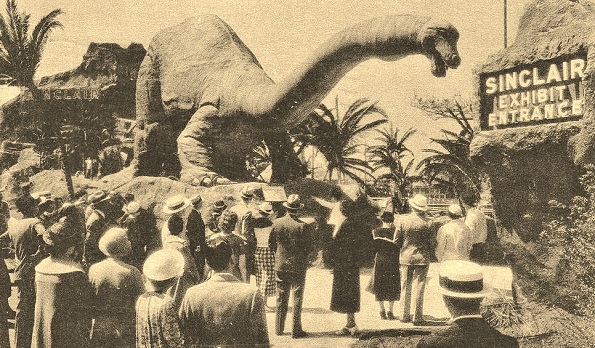
The first Sinclair Oil “Brontosaurus” trademark made its debut in Chicago as an exhibit during the 1933-1934 “Century of Progress” World’s Fair.
The prospering producing and refining company began using an Apatosaurus (then called a Brontosaurus) in its advertising, sales promotions and product labels in 1930. Children loved it. Excited crowds gathered at Sinclair Oil Company dinosaurs exhibit during the Century of Progress International Exposition, also known as the Chicago World’s Fair, from May 27, 1933, to October 31, 1934.
Sinclair Oil Company dinosaurs
As Sinclair’s dinosaur exhibit attracted Depression Era crowds. the company published a special edition newspaper, Big News, promoting the company’s diverse array of dinosaurs — and petroleum products.
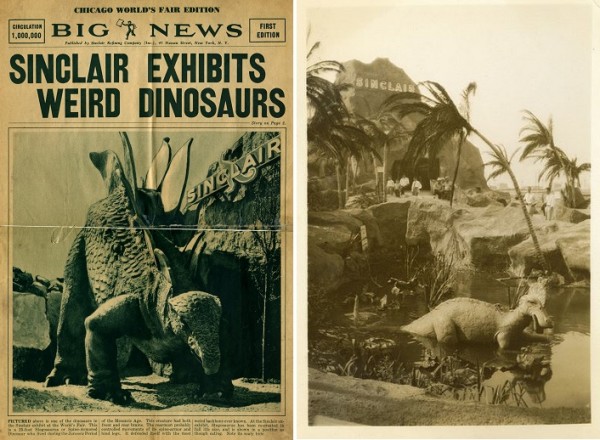
“Sinclair uses dinosaurs in its motor oil adverting to impress on your mind the tremendous age of the crude oils from which Sinclair Motor Oils are made,” proclaimed one Big News article.
The Sinclair dinosaur exhibit drew large crowds once again at the 1936 Texas Centennial Exposition. Four years later, even more visitors marveled at an improved 70-foot dinosaur in Sinclair’s “Dinoland Pavilion” at the 1939-1940 New York World’s Fair.

Sinclair’s green giant and his accompanying cast of Jurassic buddies, including Triceratops, Stegosaurus, a duck-billed Hadrosaurus, and a 20-foot-tall Tyrannosaurus Rex – were again a success, especially among young people.
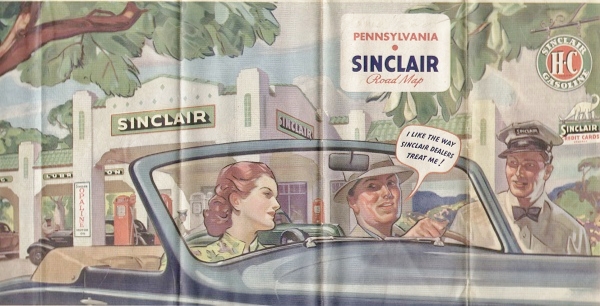
Sinclair’s first super-fuel is marketed in 1926. The “HC” initials stand for “Houston Concentrate,” but some advertising men prefer the term “High Compression.”
Although it was the first U.S. exposition to be based on the future, with an emphasis “the world of tomorrow,” the Sinclair dinosaurs remained a popular attraction among other innovative exhibits. The Westinghouse Company featured “Electro the Moto-Man,” a seven-foot robot that talked and smoked cigarettes.
“Dino” and friends would return to New York City with even greater acclaim in 1964. But it was soon after the Chicago World’s Fair that the oil company recorded its most successful single promotion.
Sinclair Dinosaurs Stamps
In 1935, Sinclair Oil published dinosaur stamps and a stamp album that could be filled only with colored dinosaur stamps — issued one at a time weekly at Sinclair service stations.
The first printing of Sinclair’s dinosaur stamp albums — distributed through its dealers within 48 hours after a single network radio broadcast of the offer — would astound marketing professionals.

In 1935, Sinclair gas stations offered dinosaur stamp albums – and eventually handed out four million albums and 48 million stamps.
“The final totals were 4 million albums and 48 million stamps,” the company noted about its campaign. “Dino” exceeded the other Sinclair Oil Company dinosaurs in becoming an icon of successful petroleum marketing wherever it went.

Refurbished, the 70-foot-long fiberglass green giant and his eight companions — including a large, 45-foot Tyrannosaurus Rex — woul return to New York for another world’s fair in 1964-1965.
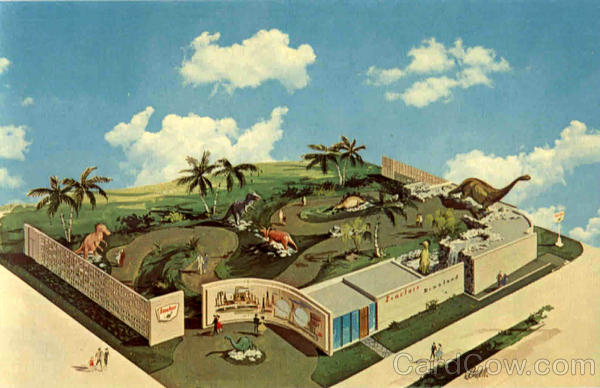
Fifty million New York City visitors attend the 1964-1965 New York World’s Fair – with the Sinclair Corporation’s “Dinoland” exhibition among the most popular of all.
In early 1964, spectators along the Hudson River were amazed to see a barge crowded with an improved Dino and his kin floating downriver. The super-sized reptiles were again bound for a New York World’s Fair. One, Triceritops, was delivered by helicopter.
New York World’s Fair
“For the first time in 70 million years a herd of dinosaurs will travel down the Hudson River this month,” noted the September 1963 issue of Popular Science.
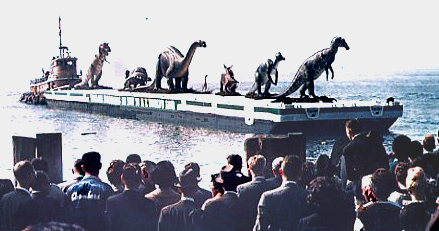
Spectators in 1964 were amazed to see a barge on the Hudson River loaded with dinosaurs.
“Faithfully sculptured and big as life,” noted the magazine, the fiberglass dinosaurs traveled by barge from the Catskill Mountains studio of animal sculptor Louis Paul Jonas, his 18 assistants and paleontologist advisers.
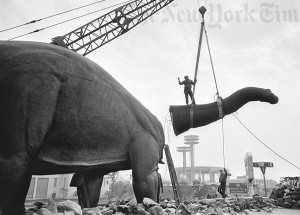
Dismantling of “the great statue that stood in the Sinclair Pavilion of the New York World’s Fair, 1965.” Photo by Robert Walker, the New York Times Archives.
The nine dinosaurs took two months and $250,000 to complete by opening day, April 22, 1964. By the end of the World’s Fair, about 50 million visitors had marvelled at Sinclair’s “Dinoland” exhibit. Dino’s travels did not end when the fair closed in October 1965.

In July 1966, the Sinclair Dinoland exhibit visited Southdale Mall in Edina, Minnesota, where Andy and Doug Ward were photographed by their father David in front of Triceratops. Photo courtesy Doug Ward.
After being disassembled and configured for an extended road trip, Dino began visiting shopping centers and other venues where crowds of children were introduced to the wonders of prehistory, courtesy of Sinclair.

Today, many fair visitors fondly remember another attraction of Sinclair’s Dinoland popular Pavilion – “Mold-A-Rama” machines that dispensed warm, plastic dinosaurs for 25 cents.
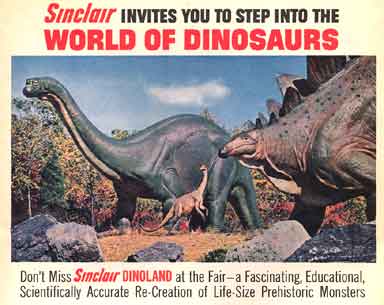
One of the New York World’s Fair dinosaurs would end up in Kansas.
After traveling more 10,000 miles through 25 states and 38 major cities, Dino retired to Dinosaur Valley State Park in Glen Rose, Texas, about 50 miles southwest of Fort Worth. He can still be seen there today. The Texas park contains some of the best preserved dinosaur tracks in the world.

Sinclair Oil Company’s 70-foot Apatosaurus (and a 45-foot Tyrannosaurus Rex) are displayed in Dinosaur Valley State Park, 50 miles southwest of Fort Worth, Texas. Photo courtesy Dinosaur Valley State Park.
“There are two fiberglass models,” the park notes, “a 70-foot Apatosaurus and a 45-foot Tyrannosaurus Rex. They were built, under commission of the Sinclair Oil Company, for New York World’s Fair Dinosaur Exhibit of 1964 – 1965.”
Orginal Corythosaurus in Kansas
Although Sinclair was born in Benwood, West Virginia, today a Wheeling suburb, he grew up in Independence, Kansas. The Historical Museum of Independence educates visitors with an Oil Room exhibiting Sinclair’s extensive Mid-Continent oilfield production and refining heritage.

Sinclair Oil Corporation distributed 48 million dinosaur stamps in a highly successful marketing campaign.
On display in a nearby public park is Corythosaurus – one the dinosaurs from Sinclair’s “Dinoland” exhibit at the 1964-65 New York World’s Fair. The museum’s Old Post Office building was placed on the National Register of Historic Places in 1988.

“The museum’s permanent exhibits in 22 rooms tell stories of the early settler’ lifestyle; the history of the oil industry; some of the Indian Culture collection and various historical artifacts,” explains the Historical Museum of Independence.
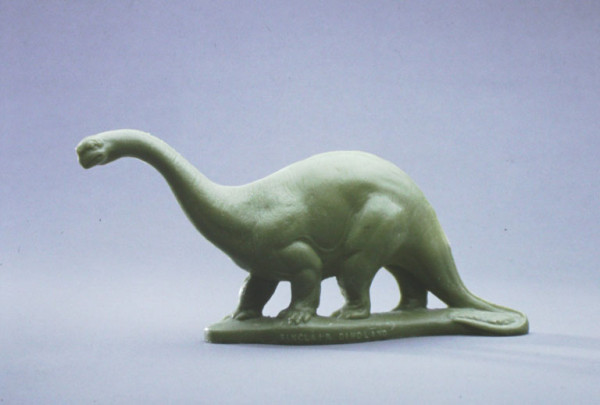
Young New Work World’s Fair visitors recall Sinclair’s “Mold-A-Rama” machine that made a souvenir dinosaur for 25 cents. “See it formed right before your very eyes!” Two sides of a mold came together, producing a still warm plastic dinosaur.
Although later a respected American industrialist, Harry Sinclair was implicated in the Teapot Dome Scandal. Albert Fall, appointed Interior Secretary in 1921 by President Warren G. Harding, was found guilty of accepting a bribe in 1929 — the first cabinet member to be convicted of a felony.
With full control of the Naval Petroleum Reserves, Fall had awarded noncompetitive leases to Sinclair’s Mammoth Oil Company for Teapot Dome oil reserves. Harry Sinclair was acquitted of giving a bribe, but served six-and-a-half months in prison for contempt of court and the U.S. Senate. He died on November 10, 1956.
_______________________
Recommended Reading: The Exciting World of Dinosaurs, Sinclair Dinoland, New York World’s Fair 1964-65 (1958); Teapot Dome Scandal (2009). Your Amazon purchase benefits the American Oil & Gas Historical Society. As an Amazon Associate, AOGHS earns a commission from qualifying purchases.
_______________________
The American Oil & Gas Historical Society (AOGHS) preserves U.S. petroleum history. Become an AOGHS annual supporting member and help maintain this energy education website and expand historical research. For more information, contact bawells@aoghs.org. © 2023 Bruce A. Wells. All rights reserved.
Citation Information – Article Title: “Dinosaur Fever – Sinclair’s Icon.” Authors: B.A. Wells and K.L. Wells. Website Name: American Oil & Gas Historical Society. URL: https://aoghs.org/oil-almanac/sinclair-dinosaur. Last Updated: April 28, 2023. Original Published Date: January 27, 2010.
by Bruce Wells | May 5, 2023 | Petroleum History Almanac
Erected for the 1953 International Petroleum Exposition, a towering roughneck evolved into an Oklahoma landmark.
With an arm resting on a steel derrick, a 76-foot oilfield worker cannot be missed by visitors to the Tulsa County Fairgrounds. Popularly known as the “Golden Driller,” the first version of the 22-ton Oklahoma roughneck appeared at the 1953 International Petroleum Exposition.
The leading oil and natural gas equipment expo, which began in 1923 as the International Petroleum Exposition and Congress, took place for decades at the Tulsa County Free Fair site. The original 1953 “roustabout” statue, conceived as a promotion by the Mid-Continent Supply Company of Fort Worth, Texas, returned in 1959 before receiving a major makeover.

Designated an Oklahoma state monument in 1979, the Golden Driller was permanently installed for the 1966 International Petroleum Exposition in Tulsa. Photo by Bruce Wells.
Refurbishment and neglect would then follow with the fortunes of the petroleum industry. But civic leaders now proclaim the the Tulsa driller the most photographed landmark in the city once known as “Oil Capital of the World.”
Although Mid-Continent Supply’s smaller first statue of 1952 impressed expo visitors, it was the 1959 version with a oilfield worker climbing a derrick that led to Tula’s current Golden Driller.

“This time he was much more chiseled and detailed and was placed climbing a derrick and waving,” explained a volunteer for the Tulsa Historical Society in 2010.
According to the society’s “Tulsa Gal,” the 1959 rig-climbing roustabout’s popularity inspired Mid-Continent Supply to donate it to the Tulsa County Fairgrounds Trust Authority when the expo ended.
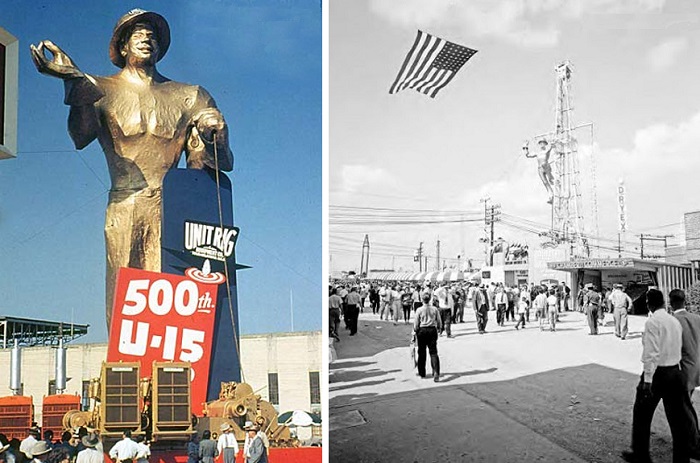
The original Golden Driller of 1953, left, proved so popular that a smaller, rig-climbing version (called The Roustabout) returned for the 1959 International Petroleum Exposition. The Tulsa fairgrounds opened in 1903. Images courtesy Tulsa Historical Society.
Over the next seven years he had a complete redesign to withstand the elements, she noted. The current Golden Driller was originally created for Tulsa’s 1966 International Petroleum Exposition. Its new look came from a Greek immigrant, George “Grecco” Hondronastas, an artist who had worked on the 1953 exposition’s statue.
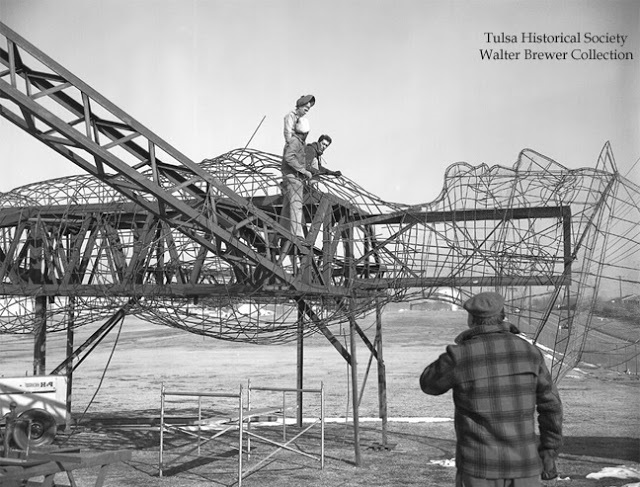
Mid-Continent Supply Company constructed a permanent version in 1966 with steel rods to withstand up to 200 mph winds. Refurbished again in 1979, it was designated a Oklahoma state monument.
According to a 2014 article by Tony Beaulieu, Hondronastas was an eccentric and prolific artist who was proud of becoming a U.S. citizen through his military service in World War I.
Hondronastas, who attended the Art Institute of Chicago and later became a professor, came to Tulsa for the first time in 1953 “to help design and build an early version of the Golden Driller,” Beaulieu explained. The artist, “fell in love with the city of Tulsa and later moved his wife and son from Chicago to a duplex near Riverview Elementary School, just south of downtown.”

Beaulieu added that “Hondronastas was always proud of designing the Golden Driller, and would tell anyone he met, according to his son, Stamatis Hondronastas.”
Learn more in An Oil Town’s Golden Idol, originally published in This Land, Vol. 5, Issue 22, November 15, 2014.
The late Tulsa photographer Walter Brewer documented construction of the giant with images later donated to the Tulsa Historical Society. Designated a state monument and refurbished again in 1979 (the year Hondronastas died), the statue as it appears today was permanently installed at East 21st Street and South Pittsburg Avenue.
The statue contains 2.5 miles of rods and mesh, along with tons of plaster and concrete. It can withstand up to 200 mph winds, “which is a good thing here in Oklahoma,” according to Tulsa Gal. It was painted it’s golden mustard shade in 2011,
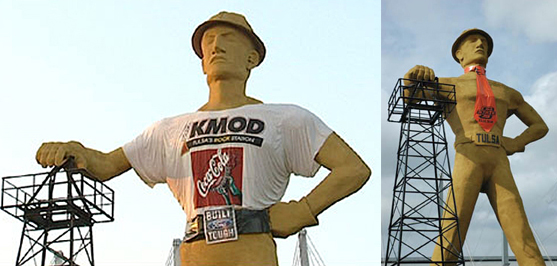
Tulsa’s giant driller has sported t-shirts, belts, beads, neckties and other promotions during state fairs. A Covid-19 mask was added in the summer of 2020. Images courtesy the Tulsa Historical Society.
The Golden Driller’s right hand rests on an old production derrick moved from oilfields near Seminole, Oklahoma – a town that has its own extensive petroleum heritage.
Fully refurbished in the late 1970s, the Golden Driller – by now a 43,500-pound tourist attraction – is the largest free-standing statue in the world, according to Tulsa city officials. “Over time the Driller has seen the good and the bad,” said Tulsa Girl. “He has been vandalized, assaulted by shotgun blasts and severe weather. But he has also had more photo sessions with tourists than any other Tulsa landmark and can boast of many who love him all around the world.”
The Golden Driller, a symbol of the International Petroleum Exposition. Dedicated to the men of the petroleum industry who by their vision and daring have created from God’s abundance a better life for mankind. – Inscription on the plaque at the statue’s base.
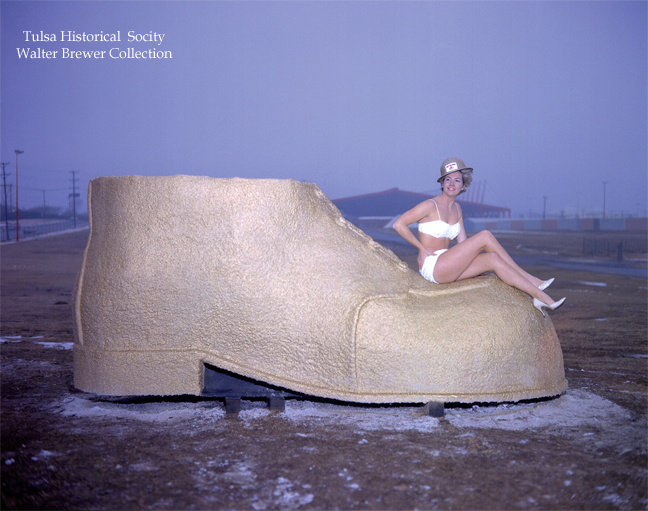
An unidentified model posed on one of the Golden Driller’s shoes, probably sometime during construction of the permanent version in time for the 1966 petroleum expo.
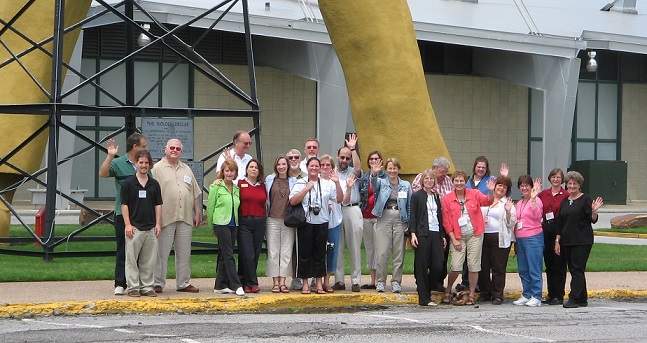
A 2007 American Oil & Gas Historical Society Energy Education Conference and Field Trip in Oklahoma City included visits to museums in Seminole, Drumright and Tulsa – with a stop at the Golden Driller. Photo by Timothy G. Wells.
Although the first International Petroleum Exposition and Congress had no giant roughneck statue in 1923, the expo helped make Tulsa famous around the world. Leading oil and gas companies were attracted to Tulsa as early as 1901, six years before Oklahoma became a state (learn more in Red Fork Gusher).

An even bigger oilfield discovery arrived in 1905 on a farm south of the future oil capital. On November 22, 1905, the The No. 1 Ida Glenn well erupted a geyser of oil southeast of Tulsa. The Glenn Pool field would forever change Tulsa and Oklahoma history.
Learn more Tulsa history in the extensive collection of the Tulsa Historical Society.
_______________________
Recommended Reading: Tulsa Oil Capital of the World, Images of America (2004); Tulsa Where the Streets Were Paved With Gold – Images of America
(2004); Tulsa Where the Streets Were Paved With Gold – Images of America (2000). Your Amazon purchase benefits the American Oil & Gas Historical Society. As an Amazon Associate, AOGHS earns a commission from qualifying purchases.
(2000). Your Amazon purchase benefits the American Oil & Gas Historical Society. As an Amazon Associate, AOGHS earns a commission from qualifying purchases.
_______________________
The American Oil & Gas Historical Society (AOGHS) preserves U.S. petroleum history. Become an AOGHS annual supporting member and help maintain this energy education website and expand historical research. For more information, contact bawells@aoghs.org. © 2023 Bruce A. Wells. All rights reserved.
Citation Information – Article Title: “Golden Driller of Tulsa.” Authors: B.A. and K.L. Wells. Website Name: American Oil & Gas Historical Society. URL: https://aoghs.org/oil-almanac/golden-driller-tulsa. Last Updated: May 6, 2023. Original Published Date: March 1, 2006.
by Bruce Wells | Mar 3, 2023 | Petroleum History Almanac
Mid-Continent discoveries and many technology advancements.
Oil discoveries, which began before statehood in 1907, by the mid-20th century had helped established leading major and independent petroleum companies.
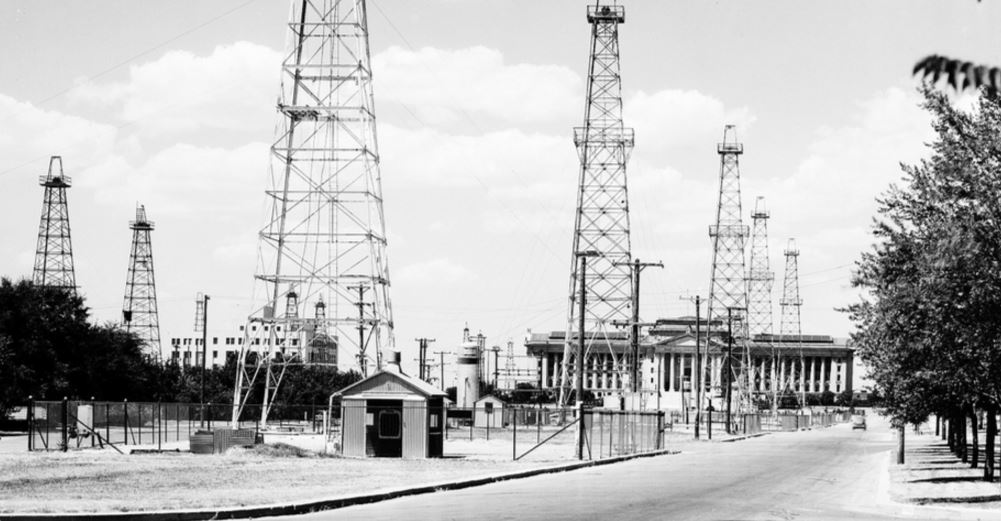
Discovered in 1928, the giant Oklahoma City oilfield added stability to the state’s economy during the Great Depression. This field alone produced more than 7.3 million barrels of oil over the next 40 years. Photo courtesy Oklahoma Historical Society.
Oklahoma’s petroleum exploration and production history began when exploration companies rushed to Indian Territory in 1897 after a column of oil erupted from a well near Bartlesville, a small town on the Caney River just south of the Kansas border.
The “wildcatters” often used steam boilers to power heavy cable tools for Making Hole – Drilling Technology. It was a technique that had evolved from using a spring pole to drill brine wells for making salt.
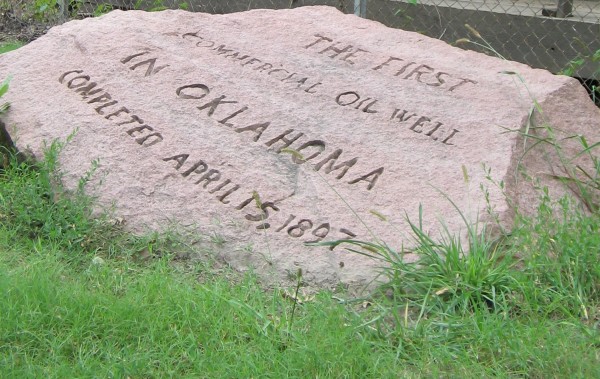
The Nellie Johnstone No. 1 well in April 1897 made Oklahoma oil history as its first discovery – and attracting hundreds of exploration companies to Bartlesville in what was then Indian Territory. Photo by Bruce Wells.
The 1897 Bartlesville oil gusher, which came a decade before statehood, was the First Oklahoma Oil Well, although some historians maintain a well drilled a decade earlier should be considered as Oklahoma’s Other First Oil Well.
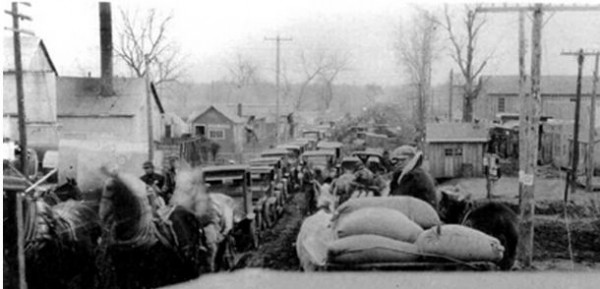
In addition to attracting exploration companies, Oklahoma’s drilling booms brought traffic jams, including this one in Seminole, Oklahoma, circa mid-1920s. Photo courtesy Oklahoma Oil Museum.
More oilfield discoveries quickly followed, each making national headlines and attracting investors seeking riches in Mid-Continent black gold.
Adding to the region’s oil fever, the 1901 Red Fork Gusher launched another historic drilling boom, soon Making Tulsa “Oil Capital of the World.”

When Missouri investors saw opportunities in the oilfields at the Kansas-Oklahoma border, they formed Cahege Oil & Gas Company. Following statehood in 1907, more major discovers made the Sooner State famous worldwide.

More than 50 refineries once operated in the Cushing area about 50 miles west of Tulsa. Pipelines and storage facilities have since made it “the pipeline crossroads of the world.” Photo from Cushing oilfield, 1910-1918, courtesy Oklahoma Historical Society.
Thomas B. Slick
In March 1912 near Cushing, the Wheeler No. 1 wildcat well produced 400 barrels a day from less than 2,350 feet deep. It marked the first of many oil gushers by an independent oilman once known as Thomas “Dry Hole” Slick.
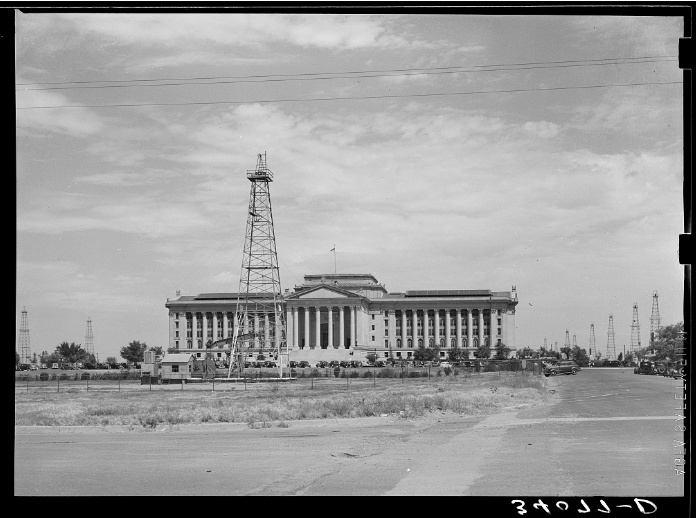
“Capitol of Oklahoma with surrounding derricks. Oklahoma City, Oklahoma,” August 1939, by Russell Lee (1903-1986) for Farm Security Administration. Photo courtesy Library of Congress.
Derricks in the Oklahoma City oilfield in 1930 stood silent for one hour in tribute to wildcatter Thomas B. Slick, who discovered Oklahoma’s giant Cushing oilfield in 1912. His drilling career include an 18-year streak discovering some of America’s most prolific oilfields, earning Slick the title of Oklahoma’s King of the Wildcatters.
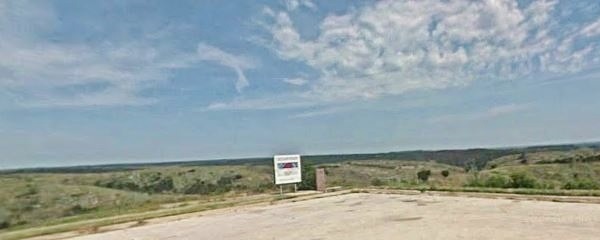
An historic marker commemorates the August 9, 1921, field testing of seismic technology. The site is located on I-35 about halfway between Oklahoma City and Dallas. Photo by Bruce Wells.
In 1915, the Bartlesville-based Cities Service Company subsidiary discovered the 34-square-mile El Dorado oilfield in Kansas.
In 1928, another subsidiary, Empire Oil & Refining, discovered the massive Oklahoma City oilfield, soon home of the headline (and news reel) making gusher, “Wild Mary Sudik.”
Thanks to a University of Oklahoma physicist, new earth-science technologies like reflection seismography began revolutionizing petroleum exploration in the 1920s. J.C. Karcher’s methods evolved from efforts to locate enemy artillery during World War I. He measured the first reflection seismograph geologic section during an experiment near Ardmore in 1921.

By the 1920s, auctions for Osage Nation mineral leases took place in the shade of a Million Dollar Elm near Pawhuska. Oil production Osage oilfields launched the careers of industry leaders like Frank Phillips, J. Paul Getty, Bill Skelly, E.W. Marland and Harry Sinclair.
South of Oklahoma City, the 1926 oilfield discovery at Seminole launched the Greater Seminole Oil Boom. More than 60 petroleum reservoirs were found in 1,300 square miles of east-central Oklahoma – and seven were giants, producing more than a million barrels of oil each.
_______________________________
The American Oil & Gas Historical Society preserves U.S. petroleum history. Become an AOGHS supporting member and help maintain this energy education website and expand historical research. For more information, contact bawells@aoghs.org. © 2024 Bruce A. Wells.
Citation Information – Article Title: “Oklahoma Oil History.” Author: Aoghs.org Editors. Website Name: American Oil & Gas Historical Society. URL: https://aoghs.org/oil-almanac/oklahoma-oil-history. Last Updated: February 15 2024. Original Published Date: March 4, 2016.
by Bruce Wells | Feb 1, 2023 | Petroleum History Almanac
by Bruce Wells | Jan 6, 2023 | Petroleum History Almanac
Grandfather scouted Philadelphia streets for earliest gas station locations.
Seeking to preserve heirlooms, families often turn to local museums, colleges, and historical societies for help. When related to petroleum business careers, the American Oil & Gas Historical Society (AOGHS) website maintains updated links to special resources, community oil and gas museums, and some help for researching old oil company stock certificates.
A 2022 addition to the AOGHS Oil & Gas Families page has its own connection with U.S. refining history — and an artifact in search of an archive home.
“I have an old Atlantic Richfield brochure that I’d be glad to donate to any interested party,” Jane Benner noted in a June 2022 email to AOGHS. “My grandfather (G.E. Cooper) and his brother (Albert Cooper) as well as a future brother-in-law (W.R. Pierce) are pictured among the staff salesmen and administrators. The handwriting identifying them is that of my grand mother, Eleanor Cooper Benner.”
The Atlantic Connecting Rod
Seeking advice for locating an interested museum, Benner attached the cover and interior photos from her family’s 1921 issue of “The Atlantic Connect Rod” (perhaps an employee publication of the Atlantic Refining Company). The Philadelphia-based venture incorporated in 1870 to refine lamp kerosene and other petroleum products.

Jane Benner’s grandfather George Edward Cooper stands among other Atlantic Refining Company salesmen and administrators in 1921.
Taken over by John D. Rockefeller’s Standard Oil Trust by the end of the 20th century, Atlantic Refining Company returned as an independent company following the U.S. Supreme Court’s dissolution of the monopoly in 1911.
With its South Philadelphia refinery among the largest in the United States, in 1966 Atlantic Refining merged with Richfield Oil Corporation, creating the Atlantic Richfield Company (ARCO). Two years later, the new major oil company made the first oil discovery in Alaska’s Prudhoe Bay, leading to construction of the Trans-Alaska Pipeline in the mid-1970s.
Early Philly Gas Stations
“All I know of my grandfather’s work is that he was responsible for identifying locations to open gas stations in Philadelphia (right side of the road, heading out of town, as my mother told me). He died in 1927, so likely his work there was during the 1910s and 1920s,” Benner explained.
The Gulf Refining Company had opened America’s first gas station in Pittsburgh in late 1913, and three years later, the company’s “Good Gulf Gasoline” also went on sale in West Philadelphia.
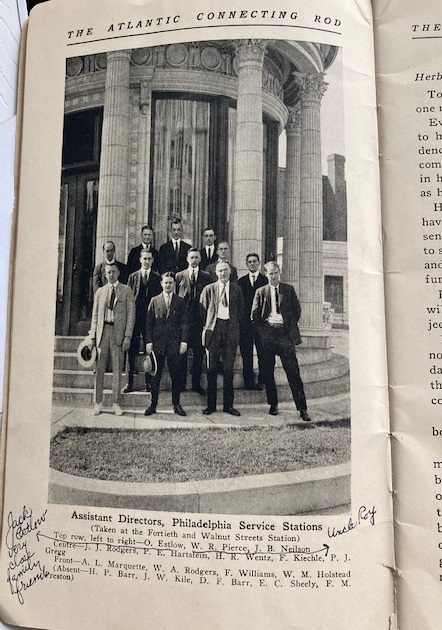
The Atlantic Refining publication features Albert Cooper, brother of Jane Benner’s grandfather, as well as a future brother-in-law (W. R. Pierce). The handwriting identifying them is that of her mother, Eleanor Cooper Benner.
The Gulf station opening at 33rd and Chestnut streets was the start of the “Battle for Gasadelphia,” according to PhillyHistory. In April 1916, Gulf added a second station at at Broad Street and Hunting Park Avenue.
“How did the competition respond? The Philadelphia and Pittsburgh-based Atlantic Refining Company formed a committee to brainstorm,” the 2013 blog noted. Gulf Refining’s first station used a distinctive pagoda style architecture. More designs would emerge to attract consumers.
Both refining companies used service station location and architecture to explore the earliest combinations of integrating functionalism with new or classical designs, noted Keith A. Sculle in his 2004 article, “Atlantic Refining Company’s Monumental Service Stations in Philadelphia, 1917-1919,” published in the Journal of American & Comparative Cultures (see Wiley Online Library).
Preserving Oil History
To find a home for her family’s Atlantic Refining artifact, Benner has been contacting Pennsylvania museums while researching more about the company and her grandfather’s career. She hopes her small but meaningful family heirloom will be preserved as part of America’s petroleum history.
“The booklet is remarkably informative about the company and their sales objectives at that time, including locations and photos of the early stations,” Benner noted in her email to AOGHS. “It’s fine to post my family story, as sparse as it is,” concluded the granddaughter of G.E. Cooper.
Benner added that she planned on contacting curators and archivists at oil museums, “in case anyone is interested.”
_______________________
Recommended Reading: An Illustrated Guide to Gas Pumps (2008). Your Amazon purchase benefits the American Oil & Gas Historical Society. As an Amazon Associate, AOGHS earns a commission from qualifying purchases.
(2008). Your Amazon purchase benefits the American Oil & Gas Historical Society. As an Amazon Associate, AOGHS earns a commission from qualifying purchases.
_______________________
The American Oil & Gas Historical Society preserves U.S. petroleum history. Become an AOGHS annual supporting member and help maintain this energy education website and expand historical research. For more information, contact bawells@aoghs.org. © 2022 Bruce A. Wells. All rights reserved.
Citation Information – Article Title: “Preserving a 1921 Atlantic Refining Publication.” Authors: B.A. Wells and K.L. Wells. Website Name: American Oil & Gas Historical Society. URL: https://aoghs.org/oil-almanac/laviness-family-oilfield-history. Last Updated: July 12, 2022. Original Published Date: July 12, 2022.


(2009). Your Amazon purchase benefits the American Oil & Gas Historical Society. As an Amazon Associate, AOGHS earns a commission from qualifying purchases.





























